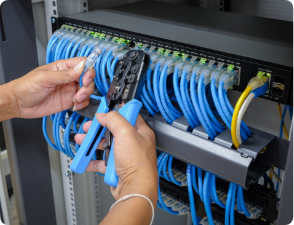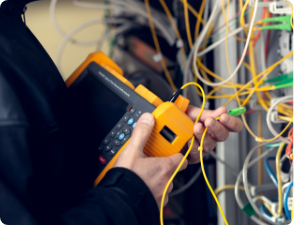-

-
400 South Salina St. Suite 201,
Syracuse, NY 13202
DESIGN ASSISTANCE
Design Assistance For A Reliable Cabling Infrastructure
Ensure you have a vigorous cabling infrastructure with our design expertise.

DESIGN A ROBUST AND DURABLE CABLING INFRASTRUCTURE
The CABLExpress® team, consisting of expert architects and specialists, is equipped to assist you in creating a robust and long-lasting cabling infrastructure for your data center.
We offer the best-in-industry comprehensive design assistance to cater to your data center needs. Our service offerings include pre-installation assessment, in-depth best practices, and multi-regional site visits by our expert design architects.
Moreover, CABLExpress has a representative in the TIA Telecommunications Cabling Systems Engineering Committee (TR-42) and a contributor and voter in the Commercial Building Telecommunications Cabling Subcommittee (TR-42.1).
WHY CHOOSE OUR DESIGN ASSISTANCE EXPERTISE?
CABLExpress offers design assistance unlike any other; our USPs are matched to your business needs!
Know more about structured cables, its importance to deliver a seamless experience and maximize system performance.
LOOKING FOR MORE OF OUR SERVICES?

CUSTOMIZED PRODUCT DEVELOPMENT
Know More

PROJECT SERVICES
Know More

DEDICATED SOLUTIONS CONSULTANT
Know More

PARTNERED INSTALLATION SERVICES
Know More
HEAR IT FROM OTHERS
My rep, the man, the myth, the legend provides service that cannot he matched. He is outstanding to work with and always does his best to look out for us on our cabling projects.
Schneider National, Inc.
,
But seriously, by far the best customer support I’ve ever received (Bar None).
Guardian Life
,
I have a great partnership with your engineering team and I have always received great customer service from my rep. Thank you for all the little things that you do to support me.
Verizon Wireless
,
Knowledgeable, professional service. Up to date knowledge of industry standards and trends, competitive pricing.
American Express
,
My rep is why. Outstanding customer service and comes through each and every time!
Staples Inc
,
FAQs
Which data center standards do you have expertise in?
Our team of design architects and experts have an in-depth understanding of current data center standards, such as ANSI/TIA-568-C, ANSI/TIA-942-A, BICSI 002 and others.
What are the design assistance services provided by CABLExpress?
CABLExpress offers comprehensive design services, including consulting assessments, best practices education, structured cabling road map, bill of materials, visual representation of the solution, racking cabinet specification, and final implementation of the design.
Where can you arrange for a site visit?
Our data center architects are based out of NY, IL, and NC and cover all of North America.
Do you actually provide pre-installation consulting services for free?
Yes, our pre-installation consultation comes at zero costs. We would just want you to consider us when you decide to implement a robust design for your data center.





